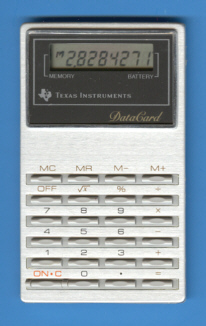
DATAMATH CALCULATOR MUSEUM
 |
DATAMATH CALCULATOR MUSEUM |
Texas Instruments TI-1760 DataCard
| Date of introduction: | August 1979 | Display technology: | LCD |
| New price: | $19.95 (SRP Sep. 1980) | Display size: | 8 |
| Size: | 3.7" x
2.2" x 0.25" 95 x 57 x 6 mm3 |
||
| Weight: | 1.3 ounces, 38 grams | Serial No: | 28245 |
| Batteries: | 2*LR54 | Date of manufacture: | wk 22 year 1979 |
| AC-Adapter: | Origin of manufacture: | El Salvador | |
| Precision: | 8 | Integrated circuits: | TP0311 |
| Memories: | 1 | ||
| Program steps: | Courtesy of: | Joerg Woerner | |
| Download manual: | |

![]()
 This
stylish TI-1760 DataCard looks different to all Texas Instruments products we know.
This
stylish TI-1760 DataCard looks different to all Texas Instruments products we know.
If we search for some other Basic calculators introduced between 1977 and 1979 we discover:
• TI-1750 TI's first
LCD-calculator introduced in 1977, manufactured in Japan
•
TI-1030 TI's first US-assembled LCD-calculator,
introduced in 1978
•
TI-1035 Typical early
LCD-calculator manufactured in Japan, introduced in 1979
It took another three years before the TI-1755 - a product assembled in Taiwan - continued the design line of the TI-1760 DataCard.
What is the story of the TI-1760? Is it another surprise like the TI-1700 DATACLIP, an US-built calculator using Toshiba technology?
 Dismantling
the TI-1760 DataCard reveals indeed a surprise, the calculator chip is the well
known Texas Instruments TP0311 design. We knew already five slimline calculators
with this chip:
Dismantling
the TI-1760 DataCard reveals indeed a surprise, the calculator chip is the well
known Texas Instruments TP0311 design. We knew already five slimline calculators
with this chip:
• TI-1001, TI-1010, TI-1030, TI-1031, TI-1750-III.
Texas Instruments used a lot of tricks to shrink the size of the
slimline series (4.6" x 2.6" x 0.4") in all
three dimensions: The calculator chip was buried into a hole of the printed
circuit board and the battery type was changed. Instead of the comfortable hood
in the back of the housing to change the batteries you must open with the
TI-1760 the complete housing.
A similar design was used with the rare Business Card and TI-1745 DataCard Time calculators.
If you have additions to the above article please email: joerg@datamath.org.
© Joerg Woerner, September 27, 2002. No reprints without written permission.